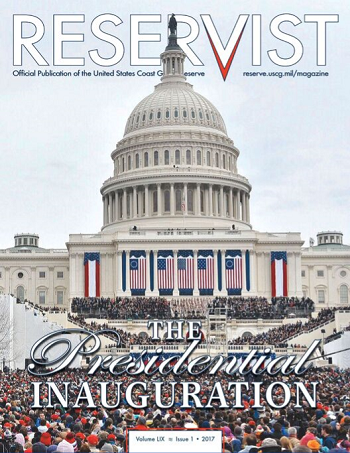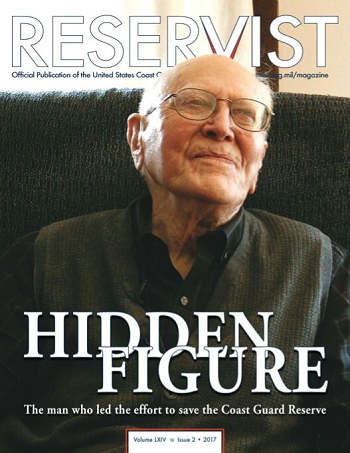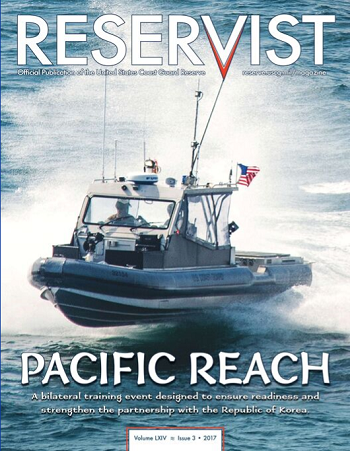
From the Editor - With my pending retirement in April, my time as Editor of the RESERVIST is drawing to a close. Depending on how the hiring process goes this could very well be my last column. So, with that in mind I would like to share the philosophy which has guided me during my tenure. I will attempt to do so by sharing an experience more than twenty years in the making.
Upon assuming the duties of editor my first priority was to ‘do no harm.’ There is a certain joy and satisfaction to be found in the responsibility of constructive stewardship. The Coast Guard, more specifically Chief Boatswain Mate Tom Branco, taught me to always leave things better than I found them. By embracing this simple wisdom, I’d like to think I have enjoyed some success in this regard.
A number of years ago I was fortunate enough to have a neighbor lady, Miss Charlotte Kent, bequeath me an old rowing dory she owned. The dory had been sitting in her boat house unattended for many, many years. Miss Kent, then in her eighties, and her sister had used the dory as young girls growing up at Kent's Point on The River in Orleans, Massachusetts.
Having spent countless days roaming the point and on The River as a child, it was really special to be entrusted with this piece of local history. According to Miss Kent, the dory was built by a local man in the early 1900s. It has a keel and ribs of oak with white cedar planking...lots of both can be found on Cape Cod.
My brother Jim and I tried to refit the dory but she needed more than we could offer. We found a local Boatwright who got her fit for the water. That was some twenty years ago. Then life happened and the dory, now rightly known as the MISS KENT, was stored away...out of sight, but not out of mind.
Last summer I met another Boatwright, Penn Colbert. Penn represents what has always been so unique and endearing about the Cape. After a brief conversation he agreed to take a look at the MISS KENT. Sometime later I got the two of them together and it was love at first sight. Penn spent the winter of 2015-16 ever so lovingly bringing the dory back to her glory days. I am very grateful for the care he has taken to get her ship shape.
My dream has always been to have her back where she belongs, on The River, where she, and I, can help a child experience the simple wonder of rowing a small but majestic vessel in one of the most beautiful places on Earth. Thanks to Penn that dream has become a reality.
And, like the MISS KENT, hopefully the RESERVIST is, in some small way, better for my time as its helm. Ultimately that is for you, the reader, to determine. What I can say is that it has been a privilege to play a small part in the magazine’s long and impressive history. There are not many publications which can say they have published continually for 64 years.span>
To my relief I offer my sincerest best wishes for continued success and share Chief Branco’s simple advice: always strive to be a good steward of what you have been entrusted.
Click cover image to download a printable pdf

From the Editor - In my last column I told you I was unsure whether or not it would be my last. Obviously, it was not.
While the machinations of the federal government hiring process have temporarily stalled the hiring of a civilian replacement, CWO Anastasia Devlin will be taking over as the RESERVIST editor. You may recognize CWO Devlin’s name as she has been providing editorial content to the magazine on a regular basis, most notably the recent yearlong focus on the 75th anniversary of the Coast Guard Reserve. A reservist herself, CWO Devlin brings a blend of active duty and Reserve public affairs expertise to the role of editor. I am very confident she will continue to provide the magazine’s readership with important and interesting information.
Speaking of interesting, the RESERVIST was extremely fortunate to discover a significant piece of Reserve history in the person of Capt. Walter K. Handy, USCGR (ret.). Capt. Handy, who turned 99 years young in March, was one of the very first members of the Reserve, enlisting in 1942. It was such a treat for me to visit with him in his western Virginia home and listen as he matter-of-factly recounted the struggles of establishing and sustaining the fledgling service: struggles that are not that much different today.
I too have struggled with what I would write as this chapter of my life’s journey comes to closure. Over the past six months two things have occurred which have influenced and solidified my thoughts as I depart an organization that has been a significant part of my life for more than 45 years. The first was reading a book given to me entitled; “The Coast Guard’s TRs” written in 1947, by Lt.j.g. Malcolm F. Willoughby, USCGR. The book recounts the extraordinary service provided to our country during the Second World War by members of the Temporary Reserve (TR). TRs were unpaid volunteers who performed all manner of Coast Guard missions – from operating picket boats to shore side patrols -- freeing up full time personnel for higher priority duties. Willoughby’s book focuses on the First Naval District (New England) but is representative of TR contributions nation-wide. The second was listening to Walter Handy speak with such pride, caring and fondness of his Coast Guard Reserve service, which spanned the dark days following the attack on Pearl Harbor up through the mid-1970s.
My take away from both is simple: while not special, reservists are unique. Why do I make that distinction between special and unique? In my view, based on nearly four decades of observation, it takes a unique individual to accept a role which is primarily, to use a sports metaphor, coming off the bench; to be productive and satisfied with the limited playing time given and gracious and accepting when it expires. And, be prepared to do it again and again – almost always with no discernible difference in performance and not infrequently at a higher level than the ‘starters’ -- to the point where it is accepted and expected as common place.
In my humble opinion it is this intangible commitment to subjugate the individual’s ego to the organization, while not expecting any quid pro quo in return, that is the common thread woven into the fabric of every reservist. To each of you I offer the following, along with my deepest admiration and respect.
Click cover image to download a printable pdf

From the Editor - It's pretty rare It’s pretty rare in your career that you walk in the door to take over an operation and find that it’s already running like a well-oiled machine. As a newspaper man and the longest-serving Reserve Force Master Chief, Jeff Smith came with skills, contacts and experience, and he spent the last five years finely-tuning this magazine. I’ve got some big shoes for me to fill, but I’m blessed to be able to lean on Jeff, still, as a mentor and a friend.
I’ve been writing articles for RESERVIST magazine for the last two years or so, and most of that time has been spent looking backward, learning the history of the component’s missions, getting to know its leaders and hearing about the challenges that shaped the Reserve. Now, sitting in the editor’s chair, I’m looking forward to exploring how the Reserve positioning itself to meet challenges in the future.
Adm. Thad Allen once said, “Transparency of information breeds self-correcting behavior.” I like that, and I believe talking about our plans and getting feedback from those who’ve come before can only make us stronger.
As a type A, I like seeing things organized, and so this job suits me. From my vantage point, I can see good people using strategy and innovation to solve problems, from schools to RCD to competencies. I’m looking forward to helping our readers understand those processes, too.
So, in true “incoming guy” fashion, I’ll keep this short. This is a dream job, and an honor. Looking forward to it.
Click cover image to download a printable pdf

From the Editor - In late August, I was on vacation in western North Carolina when I got a call from Senior Chief Ryan Doss. My family and I were staying so far back in the woods that internet was spotty, so it was the first I’d heard the news. “Houston is underwater,” Ryan said. “It’s like Katrina.
A string of hurricanes sent the Coast Guard scrambling to cover three major regions, prompting the largest recall of reservists in seven years. My husband mobilized to support the National Strike Force.
Like everyone else, I was focused on Hurricane Harvey and Irma,similarities to Hurricane Katrina, and the effects of apps and social media on rescue efforts. We created the magazine based on the response to Harvey and Irma. And then the full reports on just how badly Puerto Rico had been hit started rolling in. Just a month after I’d accepted this job as a civilian, I put my own uniform back on and left for the island. (Thanks for taking care of our boys, Mom.)
I wish I could have seen Puerto Rico when all the trees were still standing. Driving in San Juan was like the wild, wild west – few street signs and no traffic lights. Aquadilla was even worse – power lines rested on top of empty businesses in town after town. We carried our phone chargers everywhere with us, and people stayed in tents or on air mattresses. Air conditioning was a luxury, and the generator noise was unending.
Despite the logistics, Coast Guardsmen were excited to be there working, -- even on their off-days, when they volunteered to serve the surrounding community.
It always made me smile when I’d ask a group of Coast Guardsmen if there were any reservists among them. They’d all look at each other, surprised to see which shipmates were from the Reserve. The question usually hadn’t come up, because the reservists had blended so seamlessly.
I met officers and enlisted who, a month earlier, had been police officers, salesmen, nurses, technicians, fire fighters, small business owners and farmers -- all people who’d dropped their plans on 48 hours’ notice, explained to their bosses and families that they had to leave. Some reservists even left their own storm-damaged homes to put on their uniforms and report to work. It never failed to knock me back a step to hear their stories. As reservists, you know we don’t do this job for the paycheck or the accolades. It’s not always fun or convenient, but we do it because it calls to us, because it feels right to serve, and because we love doing this job alongside our brothers and sisters..
A big part of this issue focuses on photos, because there’s no better way to convey the scope of the problem our Service faced in Texas, Florida and Puerto Rico. In our next (winter) issue, we’ll feature stories on the reservists themselves.
I’m home now, but I miss Puerto Rico. I liked the PA crew I worked with, and I liked the people of Sector San Juan and Air Station Borinquen who showed such hospitality to their expanded, temporary crew. The San Juan community was sweet and welcoming, and the salsa music was joyful and intense. Man, the music just poured constantly from shops and cars and restaurants.
One day, I'm going to go back to the island, maybe when the trees are green again and the generators are gone. Until then, there's still a lot of work to be done.
Click cover image to download a printable pdf